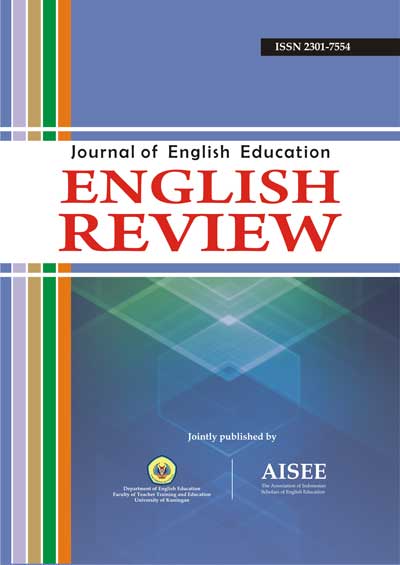THE ANALYSIS OF THEMATIC ROLE IN NARRATIVE TEXTS OF SENIOR HIGH SCHOOL TEXTBOOKS
Abstract
Abstract: This paper analyzed narrative texts of Senior High School textbooks for X Grade, based on Jackendoff’s and Saeed’s theories of thematic role. This research employed a qualitative research design and the data were ten narrative texts taken from Developing English Competencies and Interlanguage for X Grade. The research Questions involve the ways of thematic role in constructing the sentence’s meaning in narrative texts and the thematic role that mostly employed. This research revealed that nine kinds of thematic role (Agent, Patient, Location, Beneï¬ciary, Experiencer, Theme, Source, Goal, and Instrument) are available in narrative texts and the role Theme was frequently employed (260 times of 782). Meanwhile, thematic role constructs the sentence’s meaning in narrative texts by observing the verb and the preposition used in the sentence. Thematic role is a way to describe the role of noun phrase in a sentence, so that thematic role is closely related with the grammatical function. It can be also said that the analysis of thematic role in narrative texts is beneï¬cial for educational participants both teacher and student in order to recognize the sentence’s grammatical function. Therefore, thematic role helps them to understand the sentence’s meaning and ï¬nally they can grasp the message in a text.
Keywords: Thematic role, Narrative Text, Senior High School, Textbook
References
Creswell, J. W. (2007). Research design: Qualitative, quantitative, and mixed methods approaches. New Delhi: SAGE Publication India Pvt. Ltd.
Cruse, D. A. 1986. Lexical semantics. New York: Cambridge University Press.
Doddy, A et al. (2008). Developing English competencies for senior high school (SMA/ MA) Grade X. Jakarta: Departemen Pendidikan Nasional.
Dowty, D. 1991. Thematic proto-roles and argument selection. Journal of Language, 67(3), 547-619.
Fasold, R and Linton, C. Jeff. (2006). An introduction to language and linguistics. New York: Cambridge University Press.
Gerot, L. and Wignell, P. (1994). Making sense of functional grammar. Sidney: Gerd Stabler.
Goddard, C. 1998. Semantic analysis. New York: Oxford University Press.
Hornby, A. S. (1974). Oxford advanced learners dictionary of current English. Great Britain: Oxford University Press.
Hurford, J. R and Heasley, B. (1983). Semantics a course book. New York: Cambridge University Press.
Jackendoff, R. (1990). Semantic structure. England: The MIT Press.
Johansson, W. (2008). Dependency-based Semantic Analysis of Natural-language Text. Journal of Semantics.
Lyons, J. (1977). Semantics. London: Cambridge University Press.
O’Grady, W. et al. (1991). Contemporary Linguistics. New York: St Martin’s Press.
Palmer, F. R. (1995). Grammar and Meaning. New York: Cambridge University Press.
Priyana, J. et al. (2008). Interlanguage: English for senior high school students X. Jakarta: Departemen Pendidikan Nasional.
Saeed, J. I. 2009. Semantics. UK: Wiley-Blackwell.
All articles published in English Review: Journal of English Education (ERJEE) are licensed under the Creative Commons Attribution 4.0 International License (CC BY 4.0).
Copyright Ownership
Authors retain the copyright of their articles and grant ERJEE the right of first publication. The journal is granted a non-exclusive license to publish, reproduce, and distribute the article in any format, medium, or platform, provided that proper credit is given to the original authors.
License Terms – CC BY 4.0
Under the Creative Commons Attribution 4.0 International License, others are free to:
- Share — copy and redistribute the material in any medium or format
- Adapt — remix, transform, and build upon the material for any purpose, even commercially
As long as they:
- Provide appropriate credit to the original author(s) and source
- Provide a link to the license (https://creativecommons.org/licenses/by/4.0/)
- Indicate if any changes were made
There are no restrictions on the reuse, reproduction, or adaptation of published articles as long as attribution is properly given.
Author Warranties
By submitting a manuscript to ERJEE, authors confirm that:
- The work is original and does not infringe any existing copyright.
- The manuscript has not been previously published and is not under consideration elsewhere.
- All sources and references are appropriately acknowledged.
- Necessary permissions have been obtained for any copyrighted materials used.










